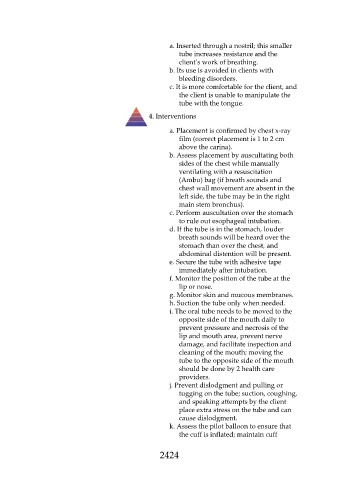Page 2424 - Saunders Comprehensive Review For NCLEX-RN
P. 2424
a. Inserted through a nostril; this smaller
tube increases resistance and the
client’s work of breathing.
b. Its use is avoided in clients with
bleeding disorders.
c. It is more comfortable for the client, and
the client is unable to manipulate the
tube with the tongue.
4. Interventions
a. Placement is confirmed by chest x-ray
film (correct placement is 1 to 2 cm
above the carina).
b. Assess placement by auscultating both
sides of the chest while manually
ventilating with a resuscitation
(Ambu) bag (if breath sounds and
chest wall movement are absent in the
left side, the tube may be in the right
main stem bronchus).
c. Perform auscultation over the stomach
to rule out esophageal intubation.
d. If the tube is in the stomach, louder
breath sounds will be heard over the
stomach than over the chest, and
abdominal distention will be present.
e. Secure the tube with adhesive tape
immediately after intubation.
f. Monitor the position of the tube at the
lip or nose.
g. Monitor skin and mucous membranes.
h. Suction the tube only when needed.
i. The oral tube needs to be moved to the
opposite side of the mouth daily to
prevent pressure and necrosis of the
lip and mouth area, prevent nerve
damage, and facilitate inspection and
cleaning of the mouth; moving the
tube to the opposite side of the mouth
should be done by 2 health care
providers.
j. Prevent dislodgment and pulling or
tugging on the tube; suction, coughing,
and speaking attempts by the client
place extra stress on the tube and can
cause dislodgment.
k. Assess the pilot balloon to ensure that
the cuff is inflated; maintain cuff
2424

